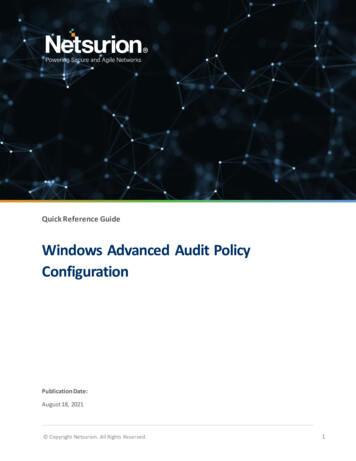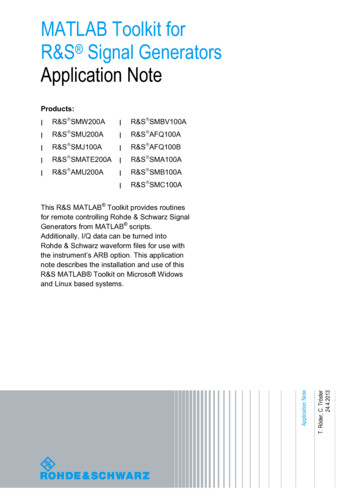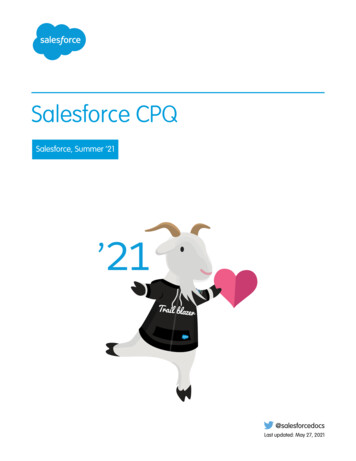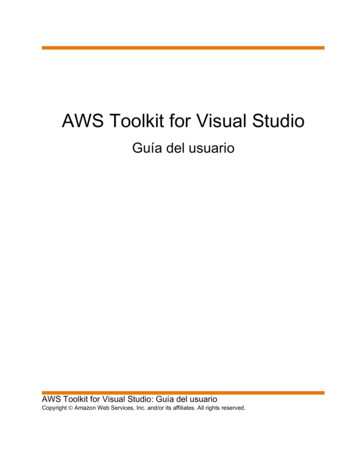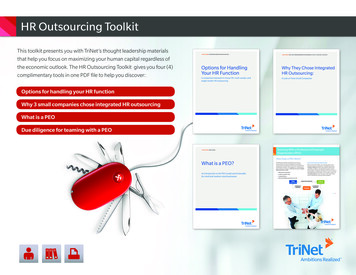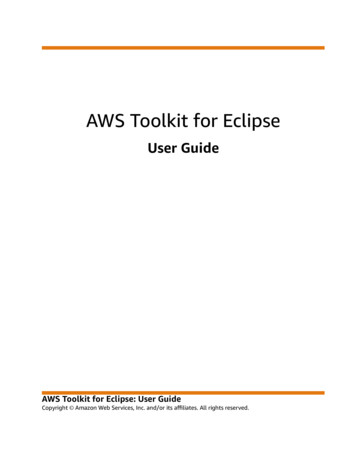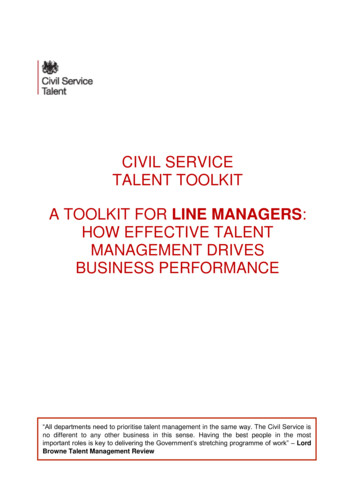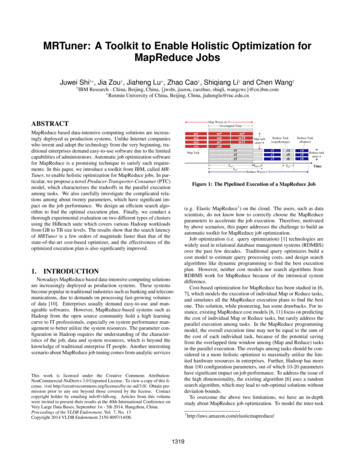
Transcription
MRTuner: A Toolkit to Enable Holistic Optimization forMapReduce JobsJuwei Shi† , Jia Zou† , Jiaheng Lu , Zhao Cao† , Shiqiang Li† and Chen Wang††IBM Research - China, Beijing, China, {jwshi, jiazou, caozhao, shiqli, wangcwc}@cn.ibm.com Renmin University of China, Beijing, China, jiahenglu@ruc.edu.cnMap Waves m 3Overlapped TimeABSTRACTMapReduce based data-intensive computing solutions are increasingly deployed as production systems. Unlike Internet companieswho invent and adopt the technology from the very beginning, traditional enterprises demand easy-to-use software due to the limitedcapabilities of administrators. Automatic job optimization softwarefor MapReduce is a promising technique to satisfy such requirements. In this paper, we introduce a toolkit from IBM, called MRTuner, to enable holistic optimization for MapReduce jobs. In particular, we propose a novel Producer-Transporter-Consumer (PTC)model, which characterizes the tradeoffs in the parallel executionamong tasks. We also carefully investigate the complicated relations among about twenty parameters, which have significant impact on the job performance. We design an efficient search algorithm to find the optimal execution plan. Finally, we conduct athorough experimental evaluation on two different types of clustersusing the HiBench suite which covers various Hadoop workloadsfrom GB to TB size levels. The results show that the search latencyof MRTuner is a few orders of magnitude faster than that of thestate-of-the-art cost-based optimizer, and the effectiveness of theoptimized execution plan is also significantly improved.m1m2m3m4m9m10m11Map taskslots 4r1r2r3Map Tasktovts1Reduce Task(copy&merge)r1r2r3tnov1r4r5r6ts2Reduce Task(Reduce)r4r5r6Reduce taskslots 3TimeReduce Waves r 2Figure 1: The Pipelined Execution of a MapReduce Job1. INTRODUCTIONNowadays MapReduce based data-intensive computing solutionsare increasingly deployed as production systems. These systemsbecome popular in traditional industries such as banking and telecommunications, due to demands on processing fast-growing volumesof data [10]. Enterprises usually demand easy-to-use and manageable softwares. However, MapReduce-based systems such asHadoop from the open source community hold a high learningcurve to IT professionals, especially on system performance management to better utilize the system resources. The parameter configuration in Hadoop requires the understanding of the characteristics of the job, data and system resources, which is beyond theknowledge of traditional enterprise IT people. Another interestingscenario about MapReduce job tuning comes from analytic servicesThis work is licensed under the Creative Commons AttributionNonCommercial-NoDerivs 3.0 Unported License. To view a copy of this license, visit http://creativecommons.org/licenses/by-nc-nd/3.0/. Obtain permission prior to any use beyond those covered by the license. Contactcopyright holder by emailing info@vldb.org. Articles from this volumewere invited to present their results at the 40th International Conference onVery Large Data Bases, September 1st - 5th 2014, Hangzhou, China.Proceedings of the VLDB Endowment, Vol. 7, No. 13Copyright 2014 VLDB Endowment 2150-8097/14/08.m5m6m7m8(e.g. Elastic MapReduce1 ) on the cloud. The users, such as datascientists, do not know how to correctly choose the MapReduceparameters to accelerate the job execution. Therefore, motivatedby above scenarios, this paper addresses the challenge to build anautomatic toolkit for MapReduce job optimization.Job optimization (i.e. query optimization) [1] technologies arewidely used in relational database management systems (RDMBS)over the past few decades. Traditional query optimizers build acost model to estimate query processing costs, and design searchalgorithms like dynamic programming to find the best executionplan. However, neither cost models nor search algorithms fromRDBMS work for MapReduce because of the intrinsical systemdifference.Cost-based optimization for MapReduce has been studied in [6,7], which models the execution of individual Map or Reduce tasks,and simulates all the MapReduce execution plans to find the bestone. This solution, while pioneering, has some drawbacks. For instance, existing MapReduce cost models [6, 11] focus on predictingthe cost of individual Map or Reduce tasks, but rarely address theparallel execution among tasks. In the MapReduce programmingmodel, the overall execution time may not be equal to the sum ofthe cost of each individual task, because of the potential savingfrom the overlapped time window among (Map and Reduce) tasksin the parallel execution. The overlaps among tasks should be considered in a more holistic optimizer to maximally utilize the limited hardware resources in enterprises. Further, Hadoop has morethan 190 configuration parameters, out of which 10-20 parametershave significant impact on job performance. To address the issue ofthe high dimensionality, the existing algorithm [6] uses a randomsearch algorithm, which may lead to sub-optimal solutions withoutdeviation bounds.To overcome the above two limitations, we have an in-depthstudy about MapReduce job optimization. To model the uce/
parallelism of a MapReduce job, we use a pipelined execution modelto describe the relations among tasks. A key property of the pipelinedmodel is that part of the Shuffle stage can be overlapped with theMap stage. An example of the pipelined execution is shown in Figure 1 (We will elaborate task slots, Map and Reduce waves andother notions in Section 3). For this job execution, parts of theShuffle tasks (r1 to r3) are overlapped with the Map tasks (m5 tom11) in the time duration tov . The overlap is affected by some critical parameters like the compression option, the number of Mapand Reduce tasks, and the number of copy threads. The overlapped time window makes the design of MapReduce cost modelschallenging, and we thereby identify a few fundamental tradeoffs(See Section 3.1 for details) to guide the design of a new MapReduce cost model. As the foundation of this study, we propose theProducer-Transporter-Consumer (PTC) cost model to characterizethe tradeoffs in the MapReduce parallel execution. The key intuition of the PTC model is that, for a MapReduce job execution plan,the generation of Map outputs (i.e. by the Producer), the transportation of Map outputs (i.e. by the Transporter) and the consumptionof Map outputs (i.e. by the Consumer) should keep pace with eachother so that utmost utilization of the system resources (CPU, disk,memory and network) is achieved to minimize the overall runningtime of the parallel execution.To address the challenge of the high dimensionality, we focus onthe search space reduction without losing the accuracy of the optimization. By investigating the complicated relations among parameters, we have two important findings. Firstly, given the identified tradeoffs, some parameters should be optimized by a holisticcost model. For example, considering the overlapped Shuffle duration, the running time of the Map stage affects that of Reducetasks, meaning that the Map and Reduce stages should not be optimized separately. Secondly, we figure out the dependencies amongparameters, and find that some parameters can be represented byexisting variables. For example, given the estimated Map selectivity (i.e. the ratio of output to input) and the average record size ofMap outputs, the size of the Map output buffer can be calculatedfrom the input split size. Thus this parameter is not an independentvariable in our cost model. As a result, the careful investigation ofrelations among different parameters facilitates the reduction of thesearch space and enables the design of a fast search method.In this paper, we introduce the design and implementation of atoolkit, namely MRTuner, to enable holistic optimization for MapReduce jobs. The toolkit has been used in IBM and with several customers for pilots. The key contributions of this paper are as follows. We design and implement a toolkit to enable holistic optimization for MapReduce jobs, which covers parameters ofMapReduce and HDFS. We identify four key factors to model the pipelined executionplan of a MapReduce job, and propose a Producer-TransporterConsumer (PTC) cost model to estimate the running time ofa MapReduce job. We figure out the relations among the performance sensitiveparameters, and design a fast search method to find the optimal execution plan. We conduct a thorough experimental evaluation on two different types of clusters using HiBench [8], covering variousworkloads from GB to TB levels. The search time of the MRTuner job optimizer outperforms that of the state of the artcost-based MapReduce optimizer by a few orders of magnitude. More importantly, MRTuner can find much better execution plans compared with existing MapReduce optimizers.16 byteSplit 0Split 1Split 2Split 3Split 4Split 5HDFSCopy & sort & mergeR byteIndex k, v (each record)Map()Map OutputBufferspillSorted memory ShuffleInput BufferFilediskmergemergeFile File FileFile File FileBuffer&Spill & MergeMap()Map()Buffer&Spill& MergeBuffer&Spill& MergeSortedFileSortedFileN copiersLast roundof mergeReduce()ReduceInputBufferSortedmerge FileCopy & sort & mergeReduce()Copy & sort & mergeReduce()Part 0Part 1Part 2HDFSFigure 2: Hadoop MapReduce InternalsAs an in-depth study of MapReduce performance, we believe theinsights in designing and evaluating MRTuner can also benefit theHadoop system administrators and IT professionals who are interested in the performance tuning of Hadoop MapReduce.The rest of the paper is organized as follows. We begin with Section 2 to introduce MapReduce. We dive into our new PTC modelin Section 3. In Section 4, we describe the architecture of MRTuner.Section 5 is devoted to the implementation of MRTuner. Then therelated work is showed in Section 6. Finally, we present the experimental results and conclude in Section 7 and 8 respectively.2.PRELIMINARIESIn this section, we introduce some preliminary knowledge aboutMapReduce in Hadoop, which will be used in the rest of this paper.Job Execution. MapReduce is a parallel computation frameworkthat executes user defined Map and Reduce functions. The taskslot capacity (i.e. the maximum number of Map or Reduce tasksthat can run simultaneously) is fixed when the cluster instance getsstarted. When a job is submitted, tasks will be assigned to slavenodes for the execution when there are available task slots on thesenodes. When the first round of Map tasks finish, Reduce tasks areable to start to transfer Map outputs. As shown in Figure 1, forexample, the number of Map and Reduce slots is 4 and 3, respectively. Given 11 Map tasks and 6 Reduce tasks, there are 3 waves(rounds) of Map tasks and 2 waves of Reduce tasks. When the firstwave of Map tasks (i.e. m1 to m4) completes, the first wave ofReduce tasks (i.e. r1 to r3) would start to copy Map outputs.Map Task. Map tasks read input records, and execute the userdefined Map function. The output records of Map tasks are collected to the Map output buffer whose structure is shown in the topleft of Figure 2. For each record, there are 16 bytes meta-data forsorting, partitioning and indexing. There are parameters to controlspill thresholds for both the meta-data and data buffers. When thebuffer exceeds the configured threshold, the buffered data will bespilled to disk. When all the Map outputs are generated, the Maptask process will merge all the spilled blocks to one sorted file. Inother words, if the size of Map outputs exceeds the threshold ofthe configured buffer, there is extra disk I/O for spill and merging.Moreover, the Map output data can be compressed to save disk I/Oand network I/O.Reduce Task. When a Reduce task starts, concurrent threads areused to copy Map outputs. The number of concurrent copy threadsis determined by a parameter. This parameter impacts the parallel execution of a job, and there is a tradeoff between the contextswitch overhead and the Shuffle throughput. When Map outputsare copied to the Reduce side, multiple rounds of on-disk and inmemory combined sort & merge are performed to prepare Reduceinputs. There is also a buffer in the Reduce side to keep Reduce inputs in memory without being spilled to disk. Finally, the outputsof Reduce tasks are written to HDFS.1320
Generate Map outputsof the ith waveStart to copy when the MapProducer m 3 2 1Diskoutputs of the first wave is ready3. A NEW COST MODEL FOR MAPREDUCEIn this section, we first elaborate the key findings in the parallelexecution of MapReduce jobs, and then present a new cost model.TransporterStart to consume Reduceinputs when all the data ofm 3 2 1 Consumer the m waves are readyDisk3.1 MapReduce Inter-task TradeoffsThe key idea of inter-task optimizations is to overlap the execution of Map and Reduce stages. To reduce the total running time ofa job, the Shuffle stage, which is network I/O bounded, is optimizedto be executed in parallel with the Map stage (without network I/O).Specifically, when the first wave of Map tasks completes, the firstwave of Reduce tasks would start to copy Map outputs while executing the second wave of Map tasks. Based on the pipelinedexecution model, we identify four key factors to characterize theMapReduce execution path and important tradeoffs.Figure 3: The Components of the PTC Modelshould minimize the number of Reduce copy threads whiletrying to catch the throughput of Map outputs generation. (T4) Selecting the number of Reduce waves r is a tradeoffbetween the amount of overlapped shuffled Map outputs andthe saved I/O overhead from buffered Reduce inputs. Sincethe buffer allocated for each Reduce task is fixed, we needto have more Reduce tasks to keep more Reduce inputs inmemory. But it comes at the cost of the potential increase ofthe number of Reduce waves, which leads to the fewer Mapoutputs that can be copied in the overlapped manner. The number of Map task waves m. The factor m is determined by the Map input split size (or the number of Maptasks) and the Map task slot capacity. The Map output compression option c. The factor c is theparameter of the Map output compression option. The copy speed in the Shuffle phase v. The factor v isdetermined by the number of parallel copiers, the networkbandwidth and the Reduce task slot capacity. The number of Reduce task waves r. The factor r is determined by the number of Reduce tasks and Reduce task slotcapacity.We analyze the impact of the key factors on job performance inthe pipelined execution shown in Figure 1. tov is the overlappedShuffle time, and we assume Reduce tasks copy Map outputs withthe amount of Dov during tov . If m increases (i.e. the number ofMap tasks increases), Dov increases (i.e. more Map outputs canbe copied in the overlapped manner), with the cost in task creation,scheduling and termination. If r increases, Dov decreases (only thefirst wave of Reduce tasks can perform the overlapped copy). Butthere is a benefit that more Reduce inputs can be hold in memorywithout being spilled to the disk, since the maximum available Reduce input buffer is fixed for each wave of Reduce tasks. When thenumber of copy threads increases, v increases, at the cost of morecontext switch overhead. If the Map stage is slowed down by thecontext switch overhead, the time window tov increases. Therefore,we summarize the following fundamental tradeoffs that should beaddressed by the MapReduce cost model.3.2 The Transporter starts to transfer Map outputs when the firstwave of Map tasks finishes. The Transporter can only pre-fetch Map outputs for the firstwave of Reduce tasks, meaning that at most 1/r of total Mapoutputs can be copied in the overlapped manner. Only the network I/O cost may be eliminated in estimatingthe running time. The disk I/O cost can not be excluded sinceboth Map and Reduce tasks preempt this resource. We assume that there is no skewness among tasks. We leaveit as future work to consider skew tasks in the PTC model(See the discussion in Section 7.3). (T1) Selecting m is a tradeoff between the time window forthe overlapped copying and task scheduling overhead. Whenm increases, more Map outputs can be transferred in theoverlapped manner, but the cost to schedule the increasedwave of Map tasks should not be neglected. Further, the overlapped time duration affects the copy speed v. (T2) The compression option c is beneficial if the cost tocompress and decompress the total Map outputs is less thanthe cost of transferring the additional amount of Map outputs without compression, excluding Dov . It means that weshould exclude the overlapped Shuffle time tov to estimatethe running time of a job. (T3) Selecting the copy speed v is a tradeoff between contextswitch overhead and the amount of overlapped shuffled data.Because of the context switch overhead of copy threads, thespeedup of transferring Map outputs may not lead to the reduction of the overall execution time. In other words, weProducer-Transporter-Consumer ModelWe propose a cost model, namely Producer-Transporter-Consumer(PTC), to model the key tradeoffs. As shown in Figure 3, the PTCmodel consists of three components: Producer, Transporter andConsumer. The Producer is responsible for reading Map inputsfrom HDFS, processing the user defined Map function, and generating Map outputs on the local disk. The Transporter is in chargeof reading Map outputs, copying it to the Reduce side, and mergingit to the disk. The Consumer needs to read Reduce inputs for theuser defined Reduce function.The assumptions of the PTC model are given as follows. For simplicity of presentation, we assume that the allocatedsystem resources of each task slot are the same. The PTCmodel can be easily extended to handle heterogeneous slots.Cost Estimation of the PTC Model. The Producer models theprocess of generating Map outputs in m waves. The main result ofthe Producer model is summarized as the following proposition.P ROPOSITION 3.1. Given the inputs D, Map and Reduce slots{Nms , Nrs } and four factors {m, r, v, c}, the running time of theProducer to process all the Map tasks isTproducer tmap (D, c) tschedule (m) tcs (D, c, v, r)(1)where tmap (·) is the running time of Map tasks. tcs (·) is the contextswitch time. tschedule (·) is the time spent on task scheduling.1321
P ROOF. Suppose that Map tasks perform only one-pass sortmerge (See optimizations in section 5.2.1), the running time tmap (·)is determined by the inputs D and the compression option c. tcs (·)is the context switch time led by parallel Reduce copy threads,which is determined by the inputs D, the compression option c, thecopy speed v and the number of Reduce waves r. Finally, for eachwave of Map tasks, there is a penalty factor tschedule (·) that represents the overhead to create, schedule and terminate tasks. Therefore, Eq 1 holds in the proposition 3.1Therefore, Proposition 3.2 shows the sum of ts1 , ts2 and tsrw ,as desired.The implementation of tmap (·), tcs (·) and tschedule (·) is given inSection 5.1. We do not have Nms and Nrs as arguments of thesefunctions since they are fixed after the cluster is started. The keydesign of the Producer model is to consider the context switch andtask scheduling overhead in the pipelined execution.The Transporter models the process of transferring Map outputs.The main result of the Transporter model is summarized as follows.Tconsumer treduce (D, c) tschedule (r) tlrw (Br ) · r (3)P ROPOSITION 3.2. Given the inputs D, Map and Reduce slots{Nms , Nrs } and four factors {m, r, v, c}, the running time of theTransporter to transfer the Map outputs ism 1m 1· Ds · Tproducermrvmm 1(2) tlrw (· Ds )), 0)mr(2mr m r 1) · Ds tlrw (Ds ))mrvwhere Tprocuder is given in Proposition 3.1. Ds is the amount oftransferred data which is determined by D and c. tlrw (x) is thetime to read and write data with the amount of x on local disk.Ttrasporter min((P ROOF. As shown in Figure 1, since only the first wave of Reduce tasks can perform copy in parallel with the Map stage, themaximum amount of Map outputs copied in the overlap manner isDo max Ds · m 1· 1r . If all the Do max can be transferred bemfore Map tasks finish (i.e. within the time window tov m 1·mm 1Tproducer tlrw ( m 1·D),where·Tisthetimetosproducermrmprocess the first m 1 waves of Map tasks, and tlrw ( m 1· Ds )mris the time to read (in the Map side) and write (in the Reduceside) shuffled data), the non-overlapped time to transfer Do max istnov1 0. Otherwise, there is the additional time tnov1 to transferMap outputs with the amount of Do max tov · v after all the Maptasks finish. Thus the running time (excluded the overlapped time)to transfer Map outputs for the first wave of Reduce tasks ism 1 1 1m 1· · · Tproducermr vmm 1 tlrw (· Ds )), 0)mrNext we derive the time to copy the rest of Map outputs Dn . Theamount of outputs generated by the last wave of Map tasks is Ds ·1. The amount of the rest of the Map outputs generated for themsecond to the rth wave of Reduce tasks is Ds · m 1· r 1. Thusmrthe time to transfer Dn ism 1 r 1 11·)·ts2 Ds · ( mmrv(2mr m r 1)· Ds mrvFinally, the running time of reading Map outputs (in the Map side)and writing Reduce inputs (in the Reduce side) is tsrw tlrw (Ds ).Based on the assumption that Map and Reduce tasks preempt thedisk I/O resource, the time tsrw can not be excluded in estimatingthe running time for the Transporter.ts1 tnov1 min((Ds ·The Consumer models the process of consuming Reduce inputs.The main result of the Consumer cost model is summarized as thefollowing proposition.P ROPOSITION 3.3. Given the inputs D, Map and Reduce slots{Nms , Nrs } and four factors {m, r, v, c}, the running time of theConsumer to consume the Reduce inputs iswhere treduce (·) is the running time to process Reduce inputs without enabling the Reduce side buffer. Br is the allocated Reduceside buffer for each Reduce task.P ROOF. treduce (·) is determined by the shuffled Map outputssize Ds . Ds is determined by the Map inputs D and the compression option c. Thus treduce () is determined by D and c. For aReduce task, the amount of Map outputs that can be hold in theReduce side buffer is Br (i.e. the amount of allocated Reduce sidebuffer for each Reduce task). Thus the total time can be saved bythe Reduce side buffer is tlrw (Br ) · r. Moreover, there is a penaltytschedule (·) to schedule Reduce tasks. Therefore, we have Eq 3 inthe proposition 3.3.Based on the results in Proposition 3.1, 3.2 and 3.3, we have theglobal cost function of the PTC model as follows.TP T C Tproducer Ttransporter Tconsumer(4)Implication of the PTC Model. We use a serial of illustrative examples with different settings of the factors to demonstrate how toaddress the tradeoffs with the PTC model. All the tasks in the samewave are shown by a single line. Since the scheduling overheadtschedule is constant, we do not show it in examples for simplicity.Figure 4 (a) shows the running time break-down when {m 3, r 1, c true, v 2}. Under this setting of the factors,we assume that: 1) The running time of each wave of Map tasks istmap 20 seconds (The unit is omitted in the following examplesfor simplicity). 2) The context switch time is tcs 5 for the secondand the third waves of Map tasks respectively. 3) The network copytime of each Map wave is ts 15. 4) For each wave of Shuffletasks, the local read and write time is tlrw tlr tlw 5 5 10. Note that tlrw can not be overlapped with the Map stage. Sowe illustratively break Map tasks in the duration of tlrw . 5) Therunning time of the wave of Reduce tasks is treduce 35.Since there is only one wave of Reduce tasks, 2/3 of the Mapoutputs can be copied in parallel with the Map stage, and the nonoverlapped copy time of the first Reduce wave is tnov1 15. Thusthe running time to transfer Map outputs is ts1 15. The totalrunning time of this job is 150.Figure 4 (b) illustrates the tradeoff T1. The factors of this job isset to be {m 1, r 1, c true, v 2}. Compared with thejob in Figure 4 (a), there is only one wave of Map tasks. Althoughthe context switch time tcs is eliminated, the copy of all the Mapoutputs can not be overlapped. This leads to additional 30 for theShuffle stage. The total running time of this job is 170.Figure 4 (c) illustrates the tradeoff T2. The factors of this job isset to be {m 3, r 1, c f alse, v 2}. In comparison to thejob in Figure 4 (a), the compression option c is disabled. The graydotted line points to the wave of Map outputs that the copy taskis responsible for. Since there is no compression/de-compressionoverhead, tmap and treduce are reduced to 5 and 15 respectively,but at the cost that both tlr and tlw are increased to 10, and ts1322
tnov1tmap tlrMaptmap tcstlr eConsumertlwReducetreduceTimeTime01020 3040 506070 80090 100 110 120 130 140 150 160 170 1801020 3040 506070 80(b)(a)tnov1Maptlr tmap tcs tlrtcs tmaptmaptnov1ProducertlrtstlwReducetmap tlr tmapMapTransporterts90 100 110 120 130 140 150 160 170 180Consumertstlwtcs tlr tmaptststlw treducetlwReducetnov1tcs 1020 3040 506070 80Time90 100 110 120 130 140 150 160 170 18001020 3040 506070 8090 100 110 120 130 140 150 160 170 180(d)(c)tmap tlr tmap ducetnov1tmap tcstlrtsConsumertlw treducetlw treduceTime01020 3040 506070 8090 100 110 120 130 140 150 160 170 180(e)Figure 4: Examples to illustrate the PTC modelis increased to 35. The context switch time for each wave tcs isincreased to 7.5 due to the increased Map outputs. Then, tnov1 isincreased to 40. The running time of this job is 145.Figure 4 (d) illustrates the tradeoff T3. The factors of this jobis set to be {m 3, r 1, c true, v 3}. Compared withthe job in Figure 4 (a), the copy speed is increased to reduce ts to10, which is obtained at the cost that the context switch time tcs isincreased to 10. Although the non-overlapped copy time tnov1 isreduced to 10, the total running time is increased to 155 due to theincreased context switch overhead. Actually, only the last wave ofReduce copy benefits from the increased copy speed.Figure 4 (e) illustrates the tradeoff T4. The factors of this jobis set to be {m 3, r 2, c true, v 2}. The number ofReduce waves is increased to 2 comparing to Figure 4 (a). Eachwave of Reduce tasks can use the Reduce side buffer to reduce diskI/O, which saves 2.5 seconds for each Reduce wave (treduce 15).Because of the reduction of the overlapped copy amount, tcs isreduced to 2.5 for each wave. Since only the first wave of Reducetasks can copy Map outputs in the overlapped manner, the totalnon-overlapped copy time is increased as tnov tnov1 tnov2 7.5 22.5 30. The running time of this job is 155.4. SYSTEM ARCHITECTUREBefore discussing the specifics of our system, we first providethe design goals of MRTuner. Integrated Self-tuning Solution. MRTuner is designed to optimize MapReduce jobs from the whole Hadoop stack including MapReduce and HDFS. Low-latency Optimizer. The MRTuner job optimizer is designed to respond in sub-second. Optimization for Job Running Time. MRTuner is designedto optimize the job running time. Note that the running timeis used to measure the execution of parallel tasks. The optimization of the running time does not conflict with that ofsystem resource utilization. Loosely Coupled with Hadoop. MRTuner is designed to beloosely coupled with Hadoop. We choose to build job profiles from the standard Hadoop log.We provide the architecture of MRTuner in Figure 5. MRTunerconsists of three components: the Catalog Manager (CM), the JobOptimizer (JBO) and the Hadoop Automatic Configuration (HAC).The CM is responsible for building and managing the catalogfor historical jobs, data and system resources. We incrementallyextract the catalog in a batch manner, and respond to the upperlayer in real time. The statistics in the catalog are collected by thejob profiler, the data profiler and the system profiler. The catalogquery engine provides API for querying these statistics.To optimize a MapReduce job, the JBO calls the Catalog Matcherto find the most similar job profile as well as related data and system information, and estimates the new job’s profile with the JobFeature Estimation component. Then, the JBO estimates the running time of potential execution plans to find the optimal one.The HAC is designed to advise the configuration time parameters (i.e. parameters that are fixed after the Hadoop instance getsstarted). The HAC covers MapReduce and HDFS.5.IMPLEMENTATIONWe implemented MRTuner on Hadoop 1.0.3 and 1.1.1. We firstdescribe the implementation of the catalog, and then present howto use the PTC model to build the MapReduce optimizer with a fastsearch capability. Finally, we present the HAC.5.1MRTuner CatalogThe MRTuner catalog is defined as a set of statistics which canbe extracted from Hadoop built-in counters [16], Hadoop configuration files and system profiling results.1323
CatalogBuildingRequestMapReduce JobOptimizationRequestJob FeatureEsimationMapReduce JobOptimizerJob Optimizer (JBO)Hadoop InstanceConfiguration RequestHadoopAutomaticConfiguration(HAC)Table 1: The selected MRTuner catalog fieldsSymbolDescriptionJob Fields for a Job JNmiNumber of Map input recordsNmoNumber of Map output recordsNriNumber of Reduce input recordsNroNumber of Reduce output recordsSmiMap input bytesSmoMap output bytesSriReduce input bytesSroReduce output bytesRmoRatio of Map output compressionData Fields for Data D D Size of the dataSBSize of DFS blocks of the DataEikLength distribution of the input keyEivLength distribution of the input valueSystem Resources
The number of Map task waves m. The factor m is de-termined by the Map input split size (or the number of Map tasks) and the Map task slot capacity. The Map output compression option c. The factor c is the parameter of the Map output compression option. The copy speed in the Shuffle phase v. The factor v is
